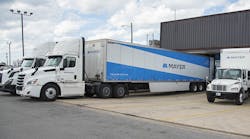The main purpose of Electrical Wholesaling's annual Distributor Source Book is to give electrical distributors basic contact information on the electrical and electronic equipment manufacturers that sell their products through distribution. Once distributors have found a new potential manufacturer, they must evaluate whether that company will make a good partner.
That's where this checklist comes in. Because of all the merger and acquisition activity on the manufacturer and distributor ends of the market spectrum, it's tougher than ever for these business partners to establish productive, long-term working relationships with each other. Many of the problems that develop between manufacturers and distributors have the same root cause: poor communication. A manufacturer's distributors can never know enough about the company, its background and distribution policies as well as about the products, services and support it offers.
This checklist will help. Electrical distributors can use it to evaluate potential and existing vendors. Manufacturers will find these questions useful, too, because they give a good idea of what distributors need to know about manufacturers and their distribution policies.
BASIC COMPANY BACKGROUND
- How large is the company (sales volume)?
- How many employees does it have?
- What is its sales history for the past five years?
- Is it publicly or privately held?
- How many manufacturing facilities does it have?
- Where are they located?
- How long has the company been in business?
- How long has the current management team been in place?
- How much experience do they have in the electrical industry?
- Who are the key contacts at the company for electrical distributors?
- How does the company headquarters communicate with distributors? Primarily through the local salesperson or through direct contact with headquarters?
- What other communication vehicles does the company use to talk with distributors?
- Are all distributors on the mailing list for the company's newsletter or annual report?
- Which industry meetings does the company attend?
- What market share does the company have in each key product area?
- Are production facilities ISO certified? If so, for how long? If not, are there any plans to do so?
- How long has the company been selling through electrical distributors?
- What percentage of the product line is sold through electrical distributors? (If applicable)
- Does the company sell through home centers?
- Which other distributors does the company sell through in this territory?
- Does the company sell through field salespeople or independent manufacturers' reps in my market?
- How long have they sold the line?
- Does the company plan to merge with or acquire another company in the immediate future?
- Is the company a member of any industry buying/marketing groups? If so, which one(s)?
PRODUCT LINES
- What products does the company manufacture?
- What are the applications for the product(s)?
- What are the sizes, ranges, grades, models, etc.?
- What special design advantages do these products have over competitive products?
- What is the main appeal of the product to my customers? Ease of use? More economical? Saving time?
- Does the company back up products with guarantees that distributors can use with customers?
- How much inventory must a distributor carry to service customer demand?
- What is the profit potential?
- Is demand for the products seasonal in any way?
- Do the products require demonstration?
- Is there any potential to use these products as door openers to sell other products that a distributor stocks?
- Should it be sold with any other related electrical products?
- Is the company developing any new products that will eventually replace or complement these products?
- Are new markets being developed for these products?
- What percentage of total sales does the company spend on research and development?
- Are any products private labeled from other companies?
- Does the company private label any product line for other manufacturers?
SALES POLICY
- What advantages does the sales policy give this company over its competition?
- Does the company have an open distribution policy, or is it selective or exclusive in any way?
- What role did distributors play, if any, in developing this sales policy?
- What qualifications must a distributor have to be selected as a distributor for the product line?
- What are the responsibilities of appointed distributors? What are the company's responsibilities toward them?
- Do distributors have any territorial restrictions? If so, how does the company arrive at them?
- Does the company have any specific policies on sales to OEMs, municipals, state and federal governments or utilities?
- Does the written sales policy clearly define the following areas?
- Activities and functions of field representatives
- Distributors' stocking requirements
- Pricing and discount structure
- Terms, cash discounts and rebates
- Product guarantees and warranties
- Returned goods policy and inventory adjustments
- Promotions and advertising support for distributors
- Protection against claims, damages and liability
- Termination of the relationship
PRICING
- Are products priced competitively?
- Does the company keep its distributors in the market when competitive situations arrive?
- Are gross margins to electrical distributors sufficient to encourage a complete sales effort on the line?
- How does the company keep distributors informed about price changes?
- Is the pricing and discount structure easy to understand?
- What are the volume discounts for electrical distributors?
- Does the company provide a cash discount? If so, what is it?
- Who pays the freight? Does it depend on quantity?
- Does the company encourage distributors to stock in anticipation of a price change?
PACKAGING AND LABELING
- What packaging options does the company offer electrical distributors?
- Bulk pack?
- Carded products?
- Tear-open cartons that can be used as displays?
- Can packaging withstand the abuse of rough handling in shipping, warehousing and on the job site?
- Is packaging sturdy and tight enough to protect the product against damage, leakage, breakage and corrosion?
- Is the packaging compatible with the units of purchase that distributors and their customers are familiar with?
- When necessary, does packaging carry measurements for the convenience of distributors and users?
- Does the packaging have a secondary use, such as for a display or as a container for spare parts?
- Can products be repackaged into smaller quantities for point-of-purchase display purposes?
- Can the products be packaged in bulk quantities in reusable storage containers such as buckets with lids that are handy around the job site?
- Does packaging attract attention from the shelf?
- Does it have a color scheme or theme that ties it to the rest of product line?
- Does the package or label highlight key product information, such as a part number, Underwriters' Laboratories listing, National Electrical Code compatibility or application information?
- Does the company have a picture of the product on the package?
- Is the catalog number easy to read to assist distributors in reordering?
- Is the label in a position on the package so that it's easy to stock or pick in the warehouse?
- Does the company allow enough room for a pricing label if it's a package for the counter area?
- Does the bar code information conform to all electrical industry standards?
MERCHANDISING AND PROMOTIONS
- What type of displays does the company have available?
- Display materials for in-line shelving?
- Stand-alone, point-of-purchase displays?
- Product demonstrators or wall boards?
- How much do they cost? Are they free with a certain size order?
- Are displays easy to clean and move around?
- Will they withstand abuse?
- Does the company offer any other merchandising tools, such as counter mats, stools, signage, clocks, etc.?
- Who is responsible for restocking displays — the distributor or the manufacturer's local salesperson?
- If the company offers product demonstrators, are they easy for a distributor to set up and use at a counter or trade show?
- Are they portable and easy to maintain?
- Do these demonstrators encourage customer participation?
- Does the company design counter layouts for distributors?
- What's included in the company's co-op advertising program?
- How does the company tie in new product rollouts with merchandising and promotions?
- How much advance notice does the company give of new product rollouts?
- What promotional campaigns does the company have running?
DISTRIBUTOR ADVISORY COUNCILS
- Does the company have a distributor advisory council?
- If so, how does the company select who is on that council?
- How long is their term?
- How many distributors are on each council?
- Who attends the council from the home office?
- Does the company president or CEO sit in on the council?
- How often does the council meet?
- How much advance preparation is required for distributors?
- Does the company send an agenda to all participants before the council so they can come prepared to discuss certain issues?
- Does the company compensate distributors for transportation and lodging?
ADVERTISING
- What does the company do to promote its products to end-users?
- Does the company advertise these products in any end-user trade magazines?
- If the company does advertise, in which publications?
- Are copies of these ads available?
- How many people read these publications?
- Who are they and what are their job functions?
- What influence do they have on the purchase of products in the market area?
- How big is the advertising campaign? What is its theme?
- How can distributors most effectively tie into this campaign?
- Can they coordinate their own promotion and sales efforts at a local level?
- Does the company sell the services of its distributors in advertisements? How?
- How does the company handle inquiries from advertising?
- How does the company promote bread-and-butter products that aren't new or part of a major campaign?
TRAINING
- Does the company conduct factory training schools for distributors?
- Are these schools held at headquarters or a central training facility, regionally or locally?
- How frequently are these schools held?
- How long is each session?
- What is the average class size?
- Who pays for it?
- What is the curriculum?
- How technical is the subject matter? Is there any assumed knowledge base for students?
- Do students get any hands-on with the products — taking them apart to see how they work, cleaning or servicing (if applicable)?
- Is a printed summary of the school's sessions available to each participant?
- Does each participant have the opportunity to critique the program and offer suggestions, and is that critique available to the participants' managers?
- How many people have graduated from the school?
- What are their names, which companies are they from, and is this list available to distributors who plan to enroll their people in the training school?
- Have these graduates been more effective in selling and promoting product line since attending the class? How does the company follow-up on this?
- Do the company's regional salespeople or independent reps follow-up on this formal training with on-site training in the field?
- Is any training available online?
PRODUCT CATALOG
- Does the company offer product catalogs or other literature to distributors?
- Does the company have separate catalogs for each product line or are all lines consolidated into one catalog?
- Is the catalog available in any electronic formats, such as on CD-ROM, diskettes or a Web site?
- If not, does the company plan to have it available electronically in the near future?
- If the catalog is available on the Web, is it the company's primary database, and the one that is updated most frequently?
- How often are print or CD-ROM catalogs updated?
- Do the descriptions for each product include all of the necessary information to specify and sell the products?
- Does the company provide space on the cover in a prominent position for a distributor imprint?
- Are catalogs styled in size and format for the convenience of end users, counter workers, inside salespeople and field personnel?
- Are products properly indexed and easy to find?
- Is that index in a logical sequence?
- Does the company charge for these catalogs?
- Does the company limit the number of catalogs a distributor gets for free?
- How does the company determine that quantity?
OTHER SELLING AIDS
- Does the company provide distributors with promotional material for direct-mail campaigns and other promotional sales efforts?
- Does the company offer application assistance or technical training on video?
- Does the company publish technical bulletins?
- How about case histories or testimonials on the company and its products or services?
- Does it publish company newsletters, e-mail newsletters, reprints from trade magazines with information on the company and/or its products?
- Do the company's sales aids dramatize how users can cut costs and/or increase their productivity through the application of products?
- Do these sales aids sell the services of its distributors and urge end users to patronize them?
- Does the company offer distributors a packaged promotion program with regular mailings to their customers or prospects?
- If so, what does it include? Who handles the customer and prospect lists at the company?
TRADE SHOWS
- At which national electrical industry trade shows does the company exhibit?
- With which of the regional or local shows is the company involved?
- Who is in charge of setting up and working in the company's booth — someone from the home office, independent reps or regional field salespeople?
- How does the company get the sales leads from trade shows to distributors? How quickly does the company distribute these leads?
ELECTRONIC COMMERCE
- Does the company communicate with distributors via e-mail?
- Does the company have a Web site? If so, what is its primary function? Does the company take orders over the site now? If not, how about in the near future?
- Are all of the products bar coded? If not, when does the company expect them to be?
- Can distributors send in orders via EDI? If the company is not on EDI, when will it be up and running?
- Is the company involved with the Industry Data Warehouse (IDW)? If not, does the company plan to?
- How does the company drive potential customers from its Web site to distributors?
- How do distributors link from their Web sites to your corporate site?








